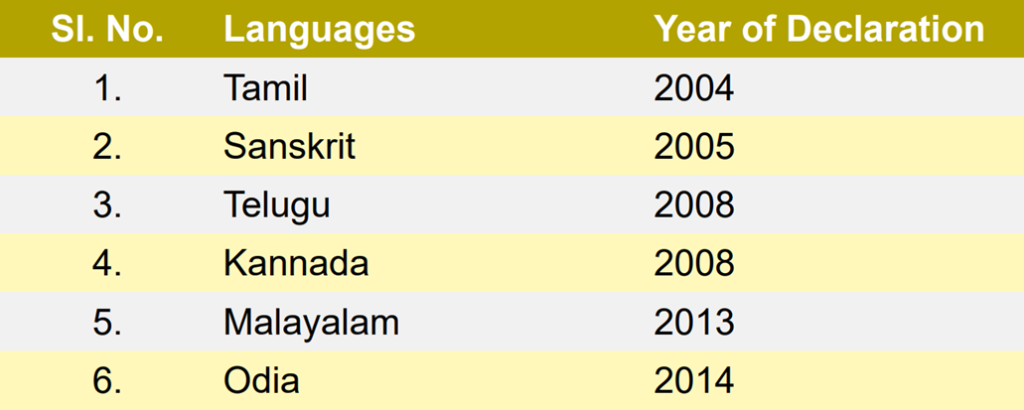Central government conferred the ‘classical language’ tag to five Indian languages — Marathi, Pali, Prakrit, Assamese and Bengali. The decisions to confer the classical language status to these languages was taken at a meeting of the Union Cabinet chaired by Prime Minister Narendra Modi.
5 New Classical Languages Approved
Why In News
- Central government conferred the ‘classical language’ tag to five Indian languages — Marathi, Pali, Prakrit, Assamese and Bengali. The decisions to confer the classical language status to these languages was taken at a meeting of the Union Cabinet chaired by Prime Minister Narendra Modi.
- This is a historical decision and this decision goes very well with Prime Minister Narendra Modi and the NDA government’s philosophy of taking pride in our culture, taking pride in our heritage and taking pride in all the Indian languages and the rich heritage that we have,” said Information and Broadcasting Minister Ashwini Vaishnaw while addressing a cabinet briefing.
- This nearly doubles the number of languages with this status, from six to 11. The newly recognised languages join the existing list of classical languages — Tamil, Sanskrit, Telugu, Kannada, Malayalam and Odia. Tamil was the first language to receive classical status in 2004, while Odia was sixth in 2014.
What Are Classical Languages
- Indian classical languages, also known as Shastriya Bhasha, refer to languages with a deep historical background, rich literary traditions and a unique cultural heritage. These languages have significantly contributed to the intellectual and cultural development of the region, with their texts offering valuable insights into various domains like literature, philosophy and religion.
Latest Criteria For “Classical Languages”
- Following criteria for declaring a classical language were outlined:
- High Antiquity: The language must have ancient texts or recorded history that extends over 1,500-2000 years.
- Valuable Heritage: A significant body of ancient literature or texts that has been preserved and valued by generations of speakers.
- Originality: The language must have a distinct and original literary tradition, not derived from another speech community.
- Distinctness from Modern Forms: There should be a clear distinction between the classical language and its modern forms, with potential discontinuity between the ancient and later versions.
What Is Behind The Recent Additions
- Marathi: With the state Assembly elections just weeks away, the inclusion of Marathi comes over a decade after the state government first forwarded the proposal to the Centre in 2013. Modern Marathi descends from Maharashtri Prakrit, a Prakrit dialect used in western India which was the official language of the Satvahanas. Some Marathi scholars have claimed that this was the first among Prakrit languages, but this claim is contested. The oldest evidence of Maharashtri Prakrit can be found in a stone inscription in Pune district, dated to the 1st century BCE. The earliest evidence of the more modern Marathi can be traced to a copper-plate inscription found in Satara, dated to 739 CE.
- Prakrit & Pali: There is no single Prakrit language. Rather, the term refers to a group of closely-related Indo-Aryan languages, whose defining feature was that they were the language of the masses as opposed to Sanskrit, which was restricted to the elites and high literature. Historian A L Basham wrote in The Wonder that was India (1954): “By the time of the Buddha the masses were speaking languages which were much simpler than Sanskrit. These were the Prakrits, of which several dialects have been attested.”
- These vernaculars were thus also the language of popular heterodox religions that emerged in the first millennium BCE.
- Jain agamas and the Gatha Saptashati are in Ardhamagadhi, a Prakrit dialect which some scholars consider to be its definitive form. This Prakrit thus continues to have resonance among the Jain community, and still sees use in the religion’s ritual practices.
- Pali, likely a form of somewhat Sanskritised Magadhi Prakrit, was the language of the Theravada Buddhist Canon — the Tipitakas. Considered to be the language of the Buddha himself, Pali survived in places like Sri Lanka, Myanmar, Thailand, Laos, and Cambodia, where the Theravada school prospered.
Benefits
- Once a language is declared classical, it receives several benefits aimed at promoting its study and preservation. These include:
- International Awards: Two major international awards are granted annually to scholars of eminence in Classical Indian Languages.
- Centre of Excellence: A Centre of Excellence for Studies in Classical Languages is established to support advanced research.
- Professional Chairs: The University Grants Commission (UGC) is requested to create Professional Chairs in central universities to support the study of these classical languages.


























